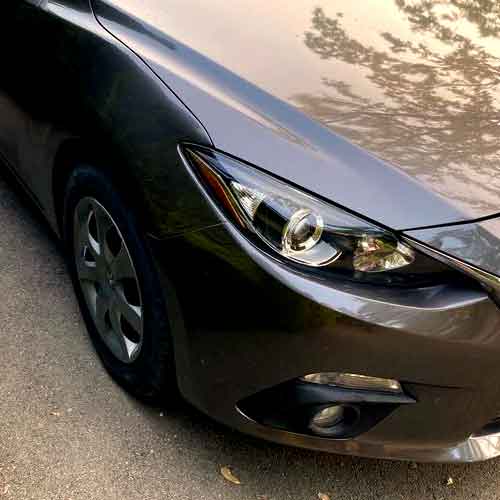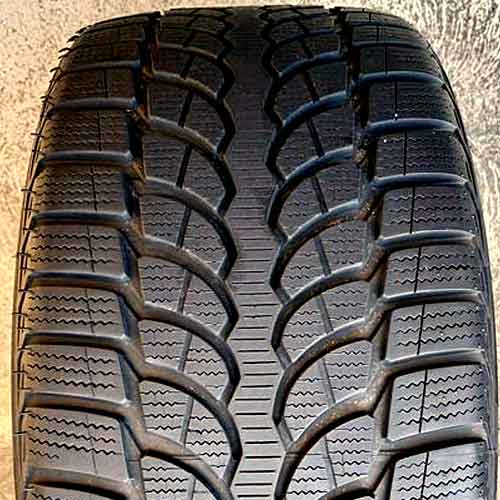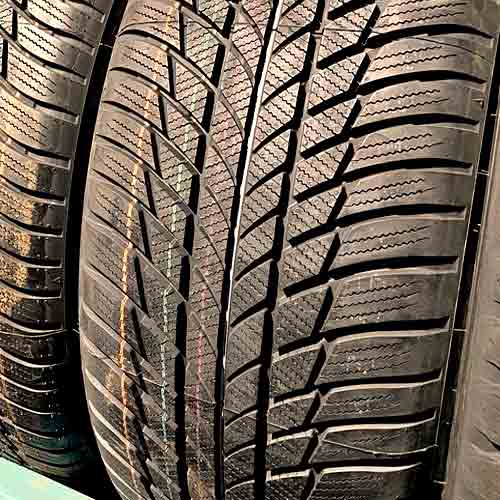The battle is on as Bridgestone Blizzak LM-32, known for its game-changing snow grip technology, faces off against Blizzak LM005, recognized for its unparalleled slush performance. Let’s see which tire is a better pick for you.

Table of Contents
Tire Sizes
The Bridgestone Blizzak LM005 comes in just 18 sizes in 18 to 20 inches rims, with following specs.
- Speed ratings: H and V.
- Load ratings: XL only.
- Tread depth: 8 to 11/32″.
- Weight: 24 to 36 lbs.
- Tread warranty: None.
On the other side, the Bridgestone Blizzak LM-32 comes in 16 to 20″ with following.
- Speed ratings: H, V and W.
- Load ratings: SL and XL.
- Tread depth: 9 to 12/32″.
- Weight: 22 to 35 lbs.
Tread Design
The Bridgestone Blizzak LM-32 .

Bridgestone Blizzak LM005 on the other hand.

Wet Performance
The tire’s traction on wet surfaces hinges greatly on the design of the tread and the composition of the rubber compound.
In this regard, the Bridgestone Blizzak LM005 shines slightly brighter than its counterpart, despite both tires featuring extensive siping.
Sipes within a tire primarily act as channels or voids that expel air and draw in water particles, thus enhancing wet grip.
Leveraging a dual siping system that combines assertive interlocking and linear designs, the Bridgestone Blizzak LM005 offers superior wet traction capabilities.
Additionally, the multi-angled sipes present in the Blizzak LM005 enhance cornering capabilities, ensuring grip in all directions.
In contrast, the Bridgestone Blizzak LM-32 opts for a different siping approach, predominantly featuring lateral sipes, resulting in slightly different traction performance.
However, it is worth noting that the Bridgestone Blizzak LM-32 excels in resisting hydroplaning, as the tire demonstrates superior “float” speeds (the maximum speed a tire can maintain over standing water without losing contact with the road) in both straight and curved water-testing scenarios.
Fluffy Snow Traction
In the realm of navigating softer, powdery snow terrains, the Bridgestone Blizzak LM-32 gains a slight advantage due to its comprehensive network of tread voids, acting as snow traps.
These snow traps facilitate increased contact between the tire and the snow, generating greater friction.
This is because, naturally, snow particles tend to adhere to one another rather than to rubber, hence enhancing traction.
On the contrary, the Bridgestone Blizzak LM005 lacks these specific characteristics, resulting in reduced snow contact with the lodged snow in the grooves.
Moreover, the tire’s smaller tread voids limit its ability to generate significant forward momentum by effectively throwing snow backwards, a feat accomplished more efficiently by the Blizzak LM-32.
Comfort Levels
When exploring the realm of comfort, there are two intertwined aspects to consider: noise reduction and the tire’s ability to gracefully glide over road shocks.
Let us delve into each element individually to gain a comprehensive understanding.
Road Noise
The origin of road noise lies within the collision of air particles against the walls of the tire’s tread, with the shoulder area being the primary gateway for these acoustic disturbances.
The general principle is that the smaller the shoulder voids, the lesser the noise generated.
And so in this regard, the Bridgestone Blizzak LM005 leads with its relatively more compact design, as it keeps the shoulder voids minimal, restricting the ingress of air and reducing the impact on the tread walls.
However, the celebration for the Blizzak LM005 is cut short by the Blizzak LM-32, which counters with its innovative pitch sequencing technology.
This technology introduces variations in the tread block geometry, causing the air particles to generate diverse sounds. These varied tones then harmoniously cancel each other out, effectively diminishing noise.
Road Bumps Absorption
Let us now explore the tires’ capability to absorb the imperfections of the road, wherein the Bridgestone Blizzak LM005 takes the lead with its softer overall tread compound.
The tire’s malleable composition allows it to gracefully soak up a greater intensity of the road irregularities, providing a smoother and more comfortable ride.
Moreover, its internal construction is also in favor of this, as you get to see more flexible plies under the hood, as well.
Fuel Usage
The fuel efficiency of tires is deeply intertwined with the design of the tread and the overall weight, as these factors directly influence the rolling resistance, a critical determinant of fuel consumption.
And in this regard, both tires showcase near identical values.
The Blizzak LM005, being lighter on average, across all sizes, yeilds slightly wider tread voids. Consequently, during maneuvers, its lugs still experience increased movement, necessitating additional fuel.
On the other hand, the Blizzak LM-32, despite its heavier weight exerting greater force on the lugs, strikes a delicate balance with its stiffer compound, resulting in equivalent fuel consumption levels.
Therefore, when it comes to fuel efficiency, both tires stand on equal footing.
Ice Traction
When venturing onto icy terrains, the Bridgestone Blizzak LM005 steals the limelight with its superior performance.
Employing advanced design techniques, such as the even distribution of specialized biters across the tread equipped with V-shaped notches, this tire achieves enhanced grip on compacted surfaces.
Moreover, with highly angled siping, the tire offers a grip in all directions, whereas on Blizzak LM-32, its only limited to lateral orientations.
Dry Directional Grip
The capacity for directional grip primarily resides within the central region of the tire’s tread, as this area bears the majority of the load during straight-line motion, as seen on highways, particularly.
So it makes sense why the Blizzak LM-32 is a better fit here.
I mean, although both tires showcase continuous central ribs to maintain consistent road contact, the Blizzak LM-32’s more compact and uninterrupted (middle) pattern contributes to a shorter braking distance, approximately 2 feet less than the Bridgestone Blizzak LM005.
Though the tire lacks when it comes to handling.
Dry Lateral Traction
The tire’s handling, or lateral traction performance, relies heavily on the tire’s shoulder structure and overall mass.
This is because, during cornering, the weight distribution shifts to the edges of the tread (shoulders/sidewalls) due to inertia, and so they connect with the road better.
Now as the shoulders on Blizzak LM005 gets to offer greater footprint, you see superior handling lap times on it, on average, that is.
Though majority of this capability is actually coming form the fact that the tire has a firmer tread compound, and so it does not allow for excessive lug bending, as the tire corners.
This allows for quicker handling times, and a more diminished over and understeering.
To Conclude
Upon assessing these tires across a wide spectrum of criteria, it becomes evident that each possesses its own appeal based on specific strengths.
The Bridgestone Blizzak LM005 distinguishes itself through commendable performance in wet traction, shock absorption, and ice traction.
On the other hand, the Bridgestone Blizzak LM-32 showcases superior performance in powdery snow traction and dry directional grip.
Furthermore, both tires perform equally in terms of fuel usage and road noise, making the ultimate choice highly dependent on individual requirements and prevailing driving conditions.